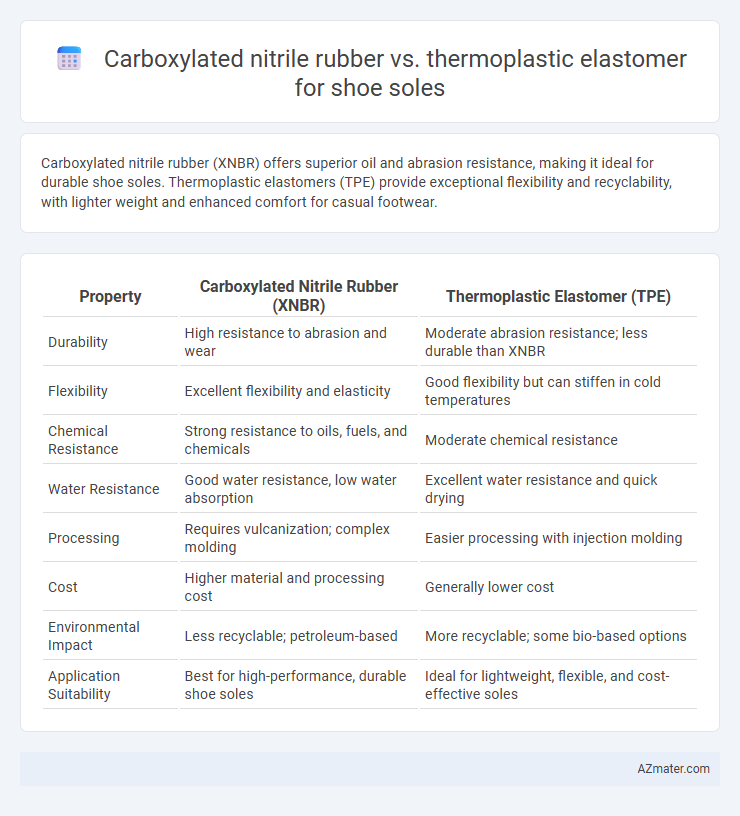Carboxylated nitrile rubber (XNBR) offers superior oil and abrasion resistance, making it ideal for durable shoe soles. Thermoplastic elastomers (TPE) provide exceptional flexibility and recyclability, with lighter weight and enhanced comfort for casual footwear.
Table of Comparison
| Property | Carboxylated Nitrile Rubber (XNBR) | Thermoplastic Elastomer (TPE) |
|---|---|---|
| Durability | High resistance to abrasion and wear | Moderate abrasion resistance; less durable than XNBR |
| Flexibility | Excellent flexibility and elasticity | Good flexibility but can stiffen in cold temperatures |
| Chemical Resistance | Strong resistance to oils, fuels, and chemicals | Moderate chemical resistance |
| Water Resistance | Good water resistance, low water absorption | Excellent water resistance and quick drying |
| Processing | Requires vulcanization; complex molding | Easier processing with injection molding |
| Cost | Higher material and processing cost | Generally lower cost |
| Environmental Impact | Less recyclable; petroleum-based | More recyclable; some bio-based options |
| Application Suitability | Best for high-performance, durable shoe soles | Ideal for lightweight, flexible, and cost-effective soles |
Introduction to Shoe Sole Materials
Carboxylated nitrile rubber (XNBR) offers superior abrasion resistance and excellent oil and chemical stability, making it ideal for durable shoe soles exposed to harsh environments. Thermoplastic elastomers (TPEs) provide flexibility and ease of manufacturing through injection molding, allowing lightweight and eco-friendly shoe sole designs with good rebound properties. The choice between XNBR and TPE depends on the required balance of performance, durability, and production efficiency in footwear applications.
What is Carboxylated Nitrile Rubber (XNBR)?
Carboxylated Nitrile Rubber (XNBR) is a type of synthetic rubber characterized by the introduction of carboxyl groups into the nitrile butadiene rubber structure, enhancing its mechanical strength, abrasion resistance, and oil resistance. XNBR's unique combination of chemical resistance and high tensile strength makes it ideal for shoe soles that require durability, slip resistance, and long-lasting performance in harsh environments. Compared to Thermoplastic Elastomers (TPE), XNBR typically offers superior resistance to oils and chemicals, making it preferable for industrial and heavy-duty footwear applications.
Understanding Thermoplastic Elastomers (TPE)
Thermoplastic elastomers (TPE) offer superior flexibility, durability, and recyclability compared to carboxylated nitrile rubber, making them ideal for shoe sole applications. TPE materials combine the elastic properties of rubber with the processing advantages of thermoplastics, enabling easy molding and customization. Their resistance to abrasion, chemicals, and environmental stress cracking enhances shoe sole performance and longevity.
Mechanical Properties Comparison: XNBR vs. TPE
Carboxylated nitrile rubber (XNBR) exhibits superior tensile strength and abrasion resistance compared to thermoplastic elastomers (TPE), making it ideal for high-performance shoe soles. XNBR offers enhanced elasticity and better tear resistance, contributing to improved durability under repeated stress. TPE materials provide easier processability and flexibility but generally have lower mechanical strength and wear resistance than XNBR.
Durability and Wear Resistance in Shoe Soles
Carboxylated nitrile rubber (XNBR) exhibits superior durability and wear resistance compared to thermoplastic elastomers (TPE) in shoe soles due to its enhanced cross-linking and chemical stability, which resist abrasion and mechanical stress effectively. XNBR's resistance to oils, greases, and environmental factors contributes to prolonged sole life in demanding conditions, whereas TPE soles, though flexible and lightweight, tend to display faster surface degradation under high friction. The higher tensile strength and abrasion resistance of XNBR make it a preferred material for durable, long-lasting shoe soles designed for intensive use.
Flexibility and Comfort: Material Performance
Carboxylated nitrile rubber (XNBR) offers superior flexibility and excellent abrasion resistance, making it ideal for shoe soles requiring durability and enhanced comfort. Thermoplastic elastomers (TPE) provide a lightweight and flexible alternative with good elastic recovery, ensuring cushioning and comfort during prolonged wear. XNBR typically excels in chemical and heat resistance, while TPE's versatility allows for easy molding and design customization, balancing comfort with performance.
Cost Analysis: XNBR vs. TPE for Manufacturers
Carboxylated nitrile rubber (XNBR) typically incurs higher raw material and processing costs compared to thermoplastic elastomers (TPE), impacting overall manufacturing expenses for shoe soles. TPE offers cost advantages due to easier processing, recyclability, and shorter cycle times, leading to reduced labor and energy costs. Manufacturers weigh these factors with XNBR's superior abrasion resistance and durability against TPE's economic efficiency and design flexibility.
Environmental Impact and Sustainability Factors
Carboxylated nitrile rubber (XNBR) offers superior chemical resistance and durability but poses environmental concerns due to its synthetic origin and limited recyclability, leading to longer decomposition times and higher carbon emissions during production. Thermoplastic elastomers (TPEs), made from a blend of polymers, provide enhanced sustainability through easier recyclability and lower energy consumption in manufacturing, significantly reducing landfill waste and enabling material reuse. TPE shoe soles contribute to a smaller ecological footprint by supporting circular economy practices, whereas XNBR soles tend to have a more substantial environmental impact over their lifecycle.
Application Suitability: Which Material for Which Shoe Type?
Carboxylated nitrile rubber (XNBR) offers superior oil resistance, durability, and grip, making it ideal for heavy-duty work boots and industrial footwear requiring enhanced chemical and abrasion protection. Thermoplastic elastomers (TPE) provide lightweight flexibility, cushioning, and ease of molding, which suits casual, athletic, and fashion shoes designed for comfort and style. Selecting the right material depends on the shoe's intended use, with XNBR preferred for rugged environments and TPE favored for everyday wear and performance-oriented footwear.
Future Trends in Shoe Sole Material Innovation
Carboxylated nitrile rubber (XNBR) offers superior oil resistance and abrasion durability compared to thermoplastic elastomers (TPE), making it ideal for high-performance shoe soles. Future trends in shoe sole innovation emphasize sustainable and recyclable materials, where TPE's thermoplastic nature allows easier recycling and customization through injection molding. Advances in material science are driving hybrid composites combining XNBR and TPE to optimize durability, flexibility, and environmental impact in next-generation footwear.

Infographic: Carboxylated nitrile rubber vs Thermoplastic elastomer for Shoe sole
 azmater.com
azmater.com